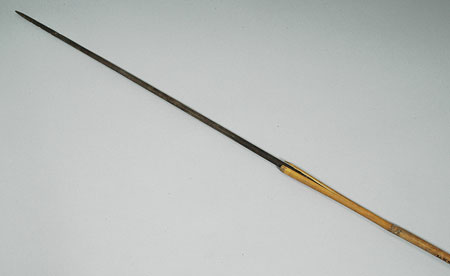Accession Number:
1944.10.72
Country:
Sudan
Region:
Blue Nile ?Darfung
Cultural Group:
?Burun
Date Made:
By 1912
Materials:
Cane Plant , Ebony Wood Plant , Animal Hide Skin , Pigment
Process:
Carved , Notched , Socketed , Bound , Decorated , Incised
Dimensions:
Total L = 1220; arrowhead L = 465, diam = 8.5 x 8; shaft L = 755, diam = 9.5 x 8.2, nock L = 15, binding L = 24, W = 2 mm [RTS 27/5/2005].
Weight:
51.6 g
Other Owners:
L. Gorringe and Mrs L. Gorringe
Field Collector:
L. Gorringe
PRM Source:
Mrs L. Gorringe
Acquired:
Donated October 1944
Collected Date:
1902 - 1912
Description:
Arrow consisting of a dark brown ebony arrowhead (Pantone black 4C), with a narrow elongated body that tapers out slightly along its length before narrowing again to its base.
The upper body below the tip has been decorated with 8 deep-cut notches that alternate down either side, making a total of 4 notches on each face.
The surface has been well finished and is very smooth.
The base of the arrowhead was originally fitted into the hollowed out top of a cane shaft, at the point where the body began to narrow again, but the arrowhead has been forced further into the shaft through use, splitting the cane body; there was therefore originally more of the point exposed than is currently the case.
This junction of tang and shaft would normally be bound with strips of hide, designed to prevent this kind of damage, but the binding has been lost.
The shaft itself is made from a length of cane with 5 segments preserved along its length, in a yellowish brown colour (Pantone 729C).
The lower part of the body has been decorated with what may be an owner's mark, consisting of a single incised zigzag on one side, and a double zigzag on the other, both coloured with reddish brown pigment (Pantone 4695C).
The base of the shaft has been bound round with a hide strip, stained a similar reddish brown colour, perhaps from the use of a fixative; below, the butt is nocked with 2 rectangular notches cut into either side.
The arrow is nearly complete, but lacks the binding that was usually be present around the upper shaft; the shaft has also split very badly at this point, and also on the lower body.
It has a weight of 51.6 grams and a total length of 1220 mm.
The visible area of the arrowhead has a length of 465 mm, but its tang extends for at least a further 80 mm into the body of the shaft, with a diameter of 8.5 by 8 mm, while the wooden shaft is 755 mm long, with a diameter of 9.5 by 8.2 mm and a nock length of 15 mm; the binding around the lower end is 24 mm long and 2 mm wide.
Collected by L. Gorringe at some time between 1902 and 1912, possibly from Darfung, and donated to the Pitt Rivers Museum by his wife, Mrs L. Gorringe.
For a group of bows collected by Gorringe, and possibly from the Burun, see 1944.10.28-34; for additional Burun arrows, see 1944.10.34-71.
Rachael Sparks 29/8/2005.
Collected by L. Gorringe at some time between 1902 and 1912, possibly from Darfung, and donated to the Pitt Rivers Museum by his wife, Mrs L. Gorringe.
For a group of bows collected by Gorringe, and possibly from the Burun, see 1944.10.28-34; for additional Burun arrows, see 1944.10.34-71.
Rachael Sparks 29/8/2005.
Primary Documentation:
Accession Book Entry
[p.
375] -
Mrs L.
GORRINGE, Rosaries Farm, Ngong, Kenya
.
Specimens collected by her late husband, Captain L.
Gorringe, M.C., in the ANGLO-EGYPTIAN SUDAN between 1902 and 1912.
Undocumented.
[p.
383] 1944.10.72-77 - [1 of] Six arrows of the same type [as 1944.10.37-71, cane shafts deeply notched with ebony spike heads tanged into the shaft], with more or less damaged shafts, one without the ebony head.
Same data [Probably the BURUN of DAR FUNG].
Card Catalogue Entry - There is no further information on the object catalogue cards ['Weapons - offensive - Archery - Arrows' RTS 23/7/2004].
Pitt Rivers Museum label - AFRICA, Sudan. Probably Burun tribe of Darfung. Cane arrow with ebony point. Don. Mrs L. Gorringe. 1944.10.72 [plastic label, tied to object; RTS 27/5/2005].
Written on object - BURUN, DAR FUNG, A.-E. SUDAN. 1944.10.72 [RTS 24/5/2005].
Card Catalogue Entry - There is no further information on the object catalogue cards ['Weapons - offensive - Archery - Arrows' RTS 23/7/2004].
Pitt Rivers Museum label - AFRICA, Sudan. Probably Burun tribe of Darfung. Cane arrow with ebony point. Don. Mrs L. Gorringe. 1944.10.72 [plastic label, tied to object; RTS 27/5/2005].
Written on object - BURUN, DAR FUNG, A.-E. SUDAN. 1944.10.72 [RTS 24/5/2005].







